Applying for British citizenship is an expensive business. At time of writing applications cost £1012 for children (although it is possible to apply for a fee waiver) and a whopping £1330 for adults, with no fee waiver availible. With such large sums of money involved, and without the prospect of any refunds if the application is unsuccessful, the thought of making the application can be extremely daunting.
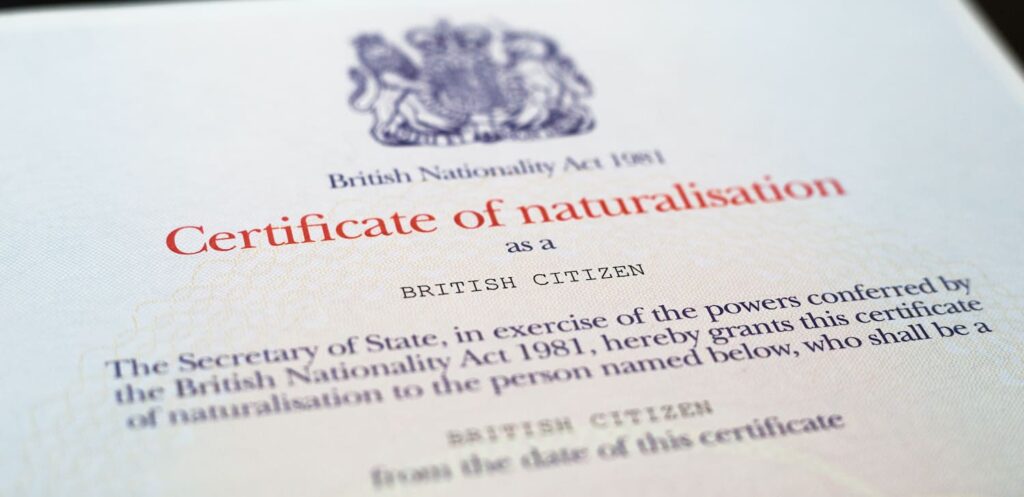
However, if you qualify for citizenship the application is actually a lot more straightforward than you might think, and you might surprise yourself with how well you’re able to complete it. This guide will take you through the process step by step, and will ensure you don’t waste any money as long as you qualify.
This will be a guide to applying for citizenship for adults with Indefinite Leave to Remain/Settlement/EU Settled Status, and given who we are it will be framed as if you arrived in the UK as a refugee.
[NOTE: THIS IS A GENERAL GUIDE AND DOES NOT GUARANTEE SUCCESS IF YOU DO NOT QUALIFY FOR CITIZENSHIP. If you have any doubts about your immigration status please speak to an immigration advisor before paying for the application)
First, we need to check that you qualify:
- Are you over 18?
- Have you had Indefinite Leave to Remain or other settled status for more than a year?
- Have you been in the UK for five years, not spending more than 450 days out of the country and no more than 90 days in the last year?
- Have you passed the Life in the UK test and passed an English test at an approved test centre at B1 or above? (a degree in English or being from an English speaking country also proves your English level)
- If you have any criminal record, including driving fines, or any experiences with bankruptcy, please speak to an advisor before paying for the application
If you qualify, then head to the gov.uk website and let’s get started!
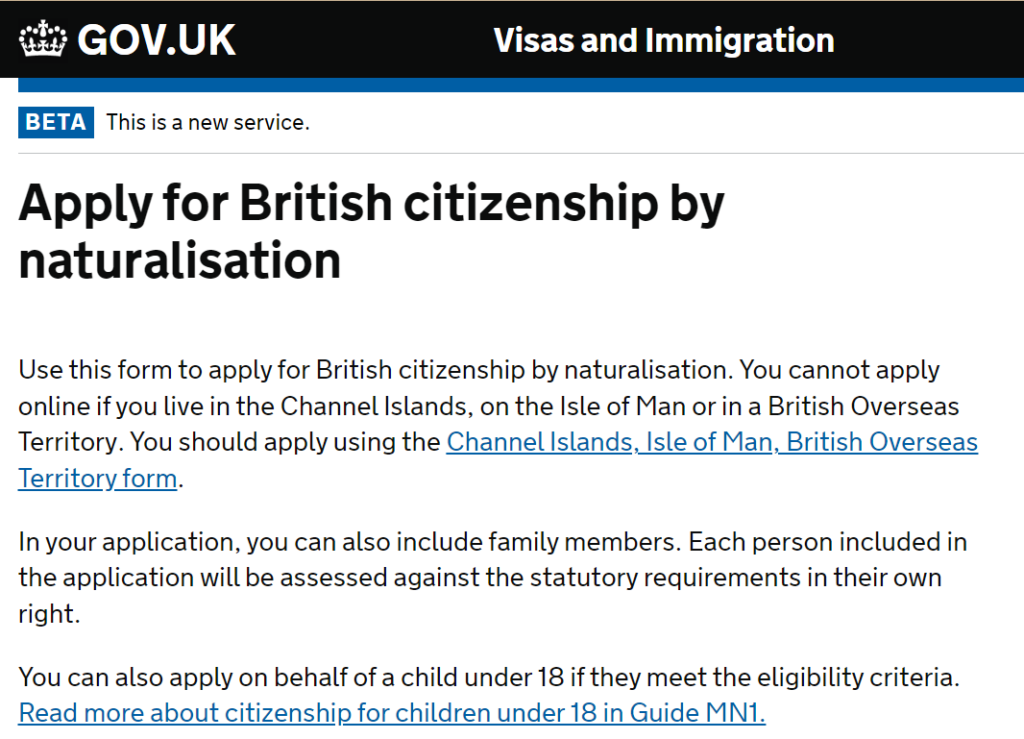
This page will outline the things you will need to get citizenship and explains how the application will work. Once you’re ready, press the green button at the bottom of the page:

The first question is if you’re in the UK. That’s easy enough: yes I am:

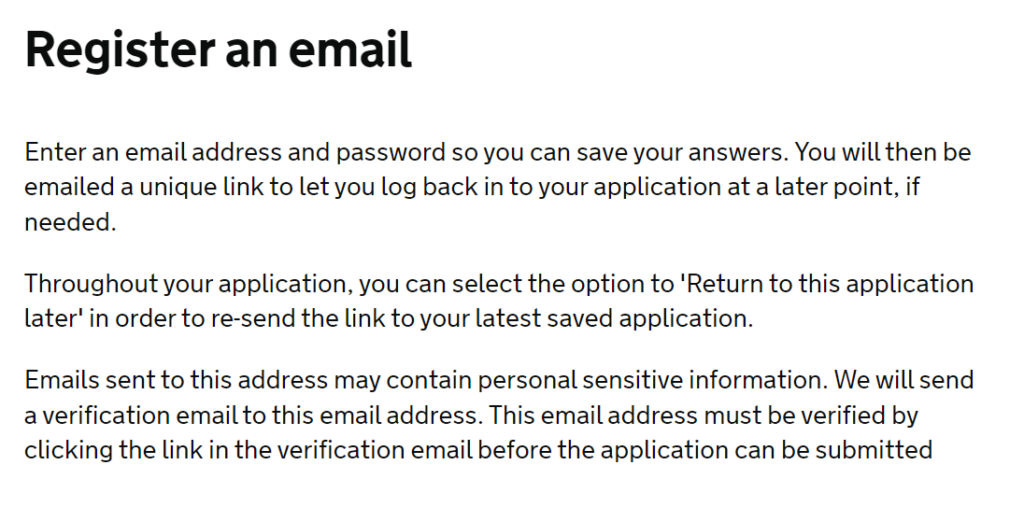
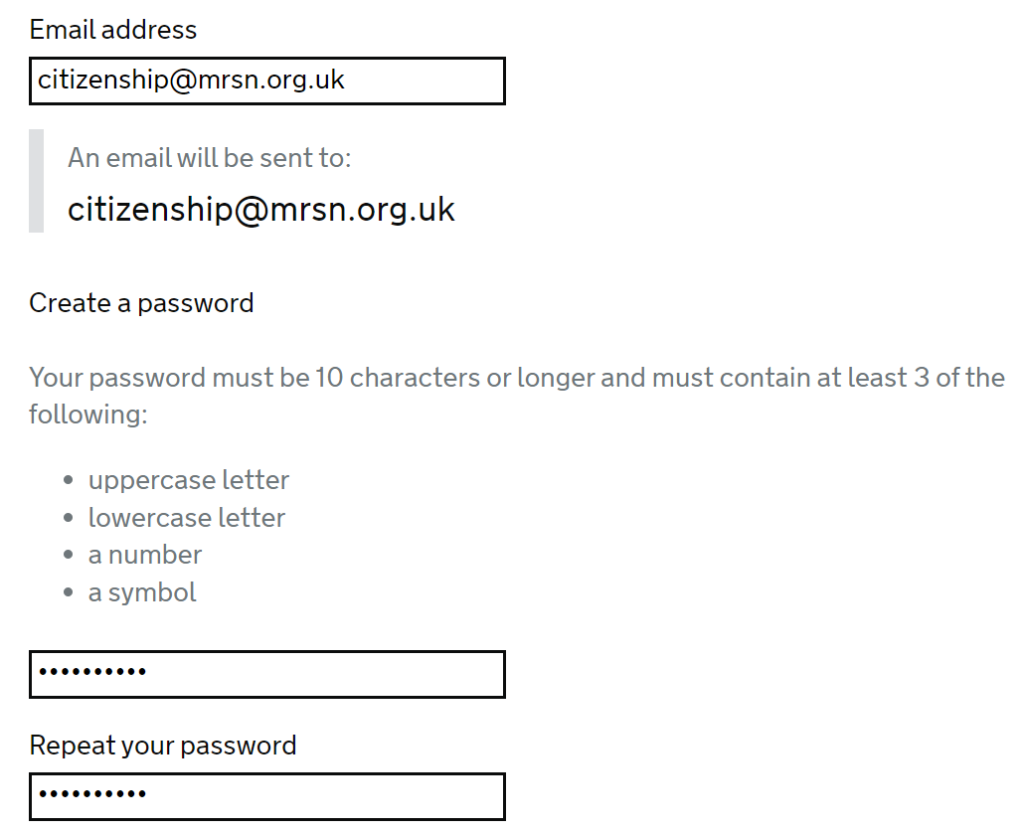
It then asks you to register an email and choose a password. I entered my email (citizenship@mrsn.org.uk) and chose the password ‘Kenta@1967’ because that’s my name and year of birth. The application will then send you two emails:

You need to click on the one that’s asking you to ‘verify your email’, which will look like this:
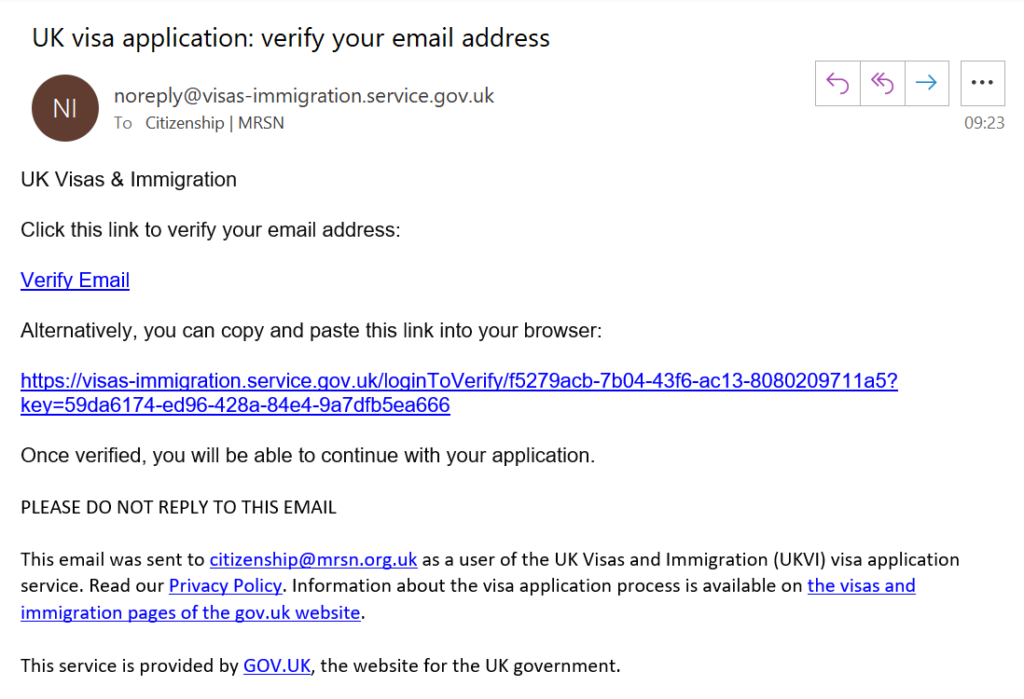
Click on either ‘Verify Email’ or the longer weblink,
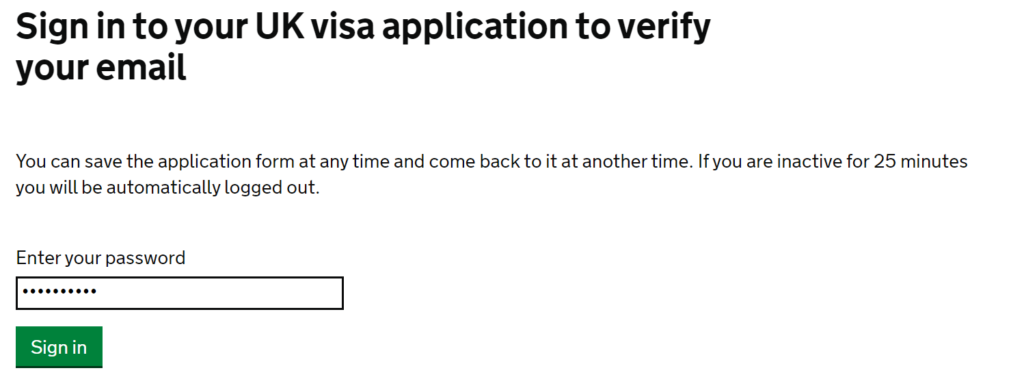
Enter the password that you created at the start and press ‘Sign in’:

And your address is verified! You’re ready to continue.

First, I’m going to confirm that the email address belongs to me, the applicant.

Next it asks if I have an immigration advisor. I don’t, and neither do you, we’re doing this application by ourselves and not being advised.
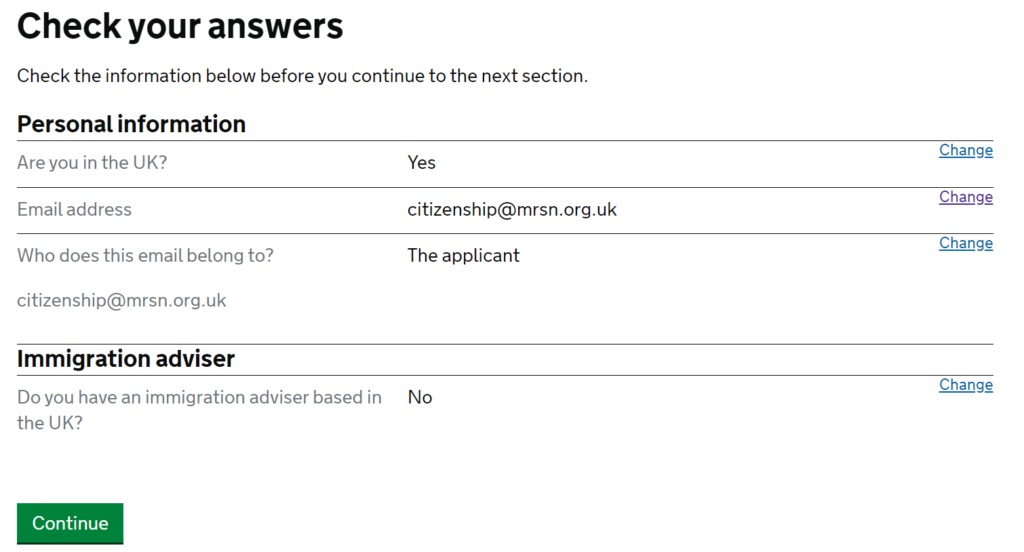
Then there’s an opportunity to check the answers you’ve given so far. If this all looks good, press continue.
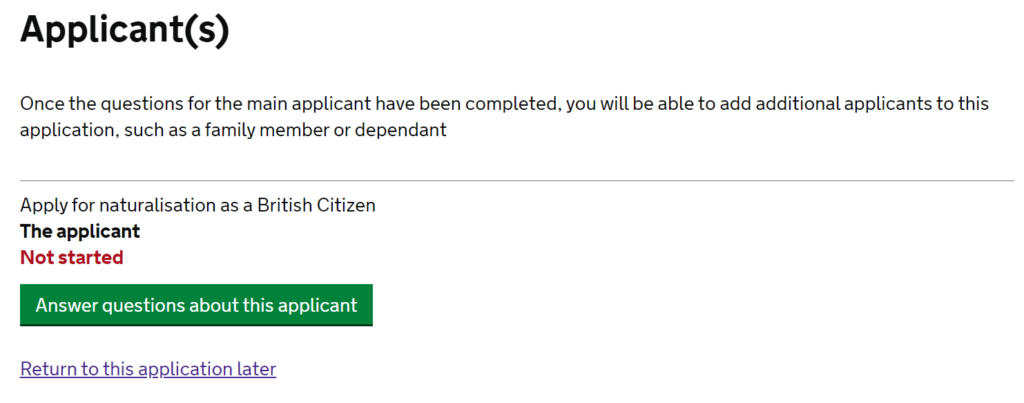
And finally we’re ready to start! When we click ‘Answer about this applicant’ we can start entering our details. It’s also good to know about the link at the bottom of every page:

When you click on this link, you’ll be shown this page:
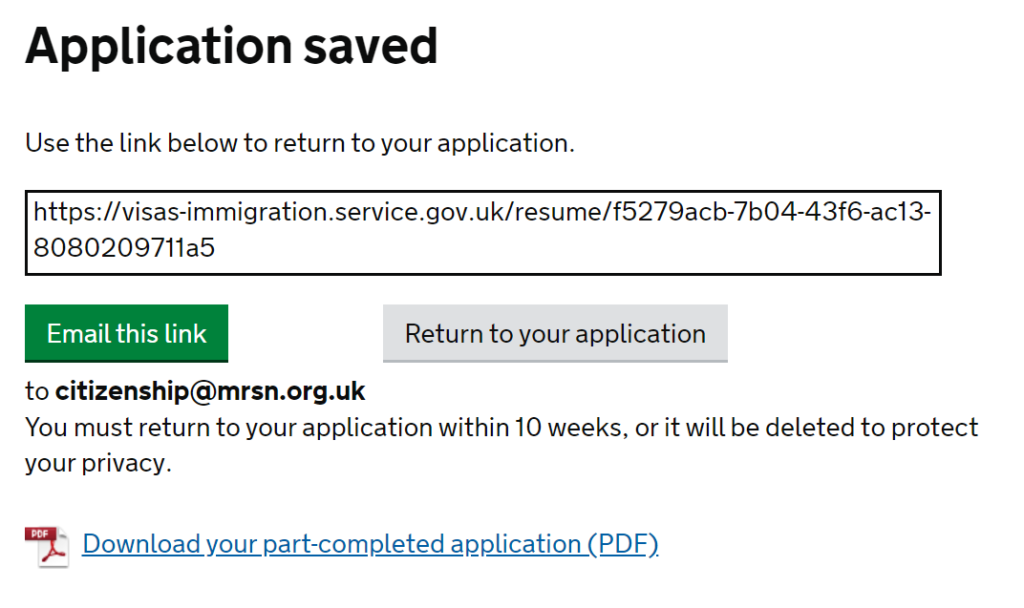
This will give you a link to your application, and also gives you the option of emailing the link to yourself. This is helpful if you want to come back to your application later and is always an option. Anyway, let’s get back to our application:
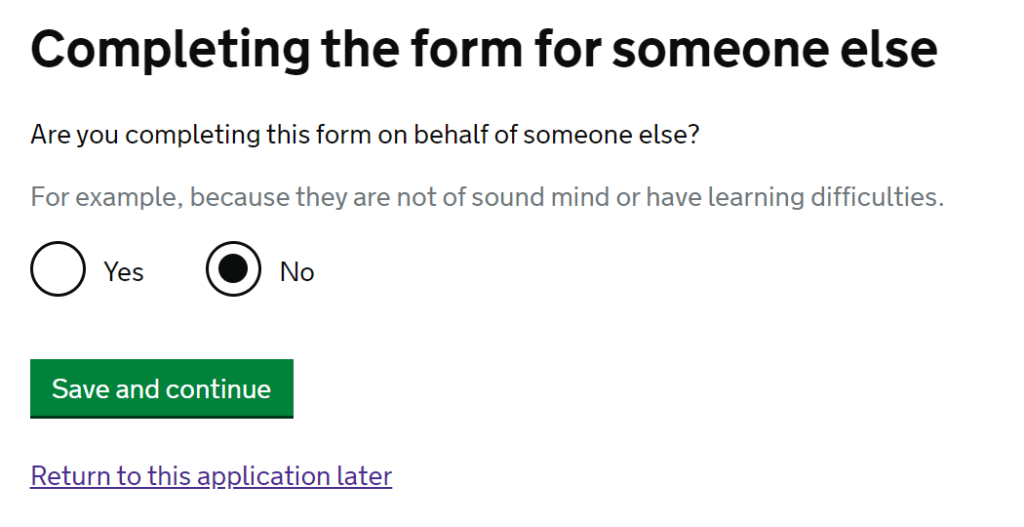
Are we completing this for someone else? No, we’re doing it for ourselves.
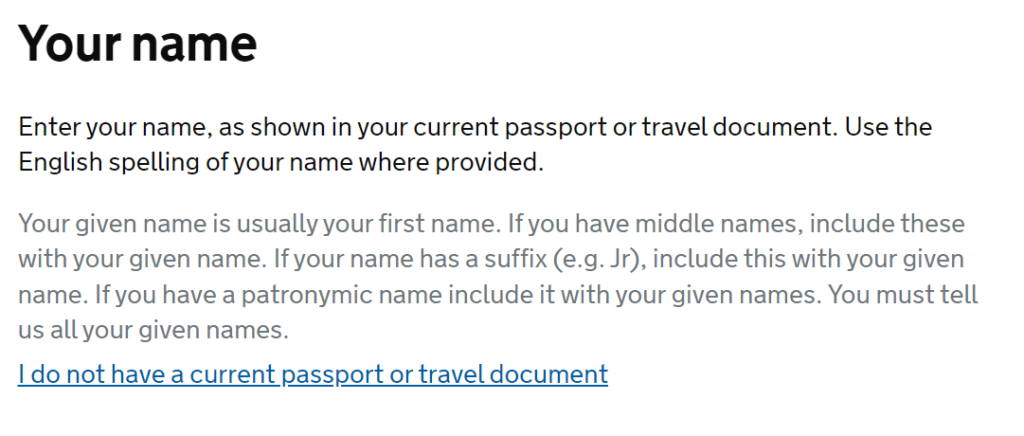
Next, it asks about our name. Remember to enter our name exactly as it appears on your Biometric Residence Permit (BRP) card or passport/Travel Document.

This is my first and last name, Kenta Kobashi.
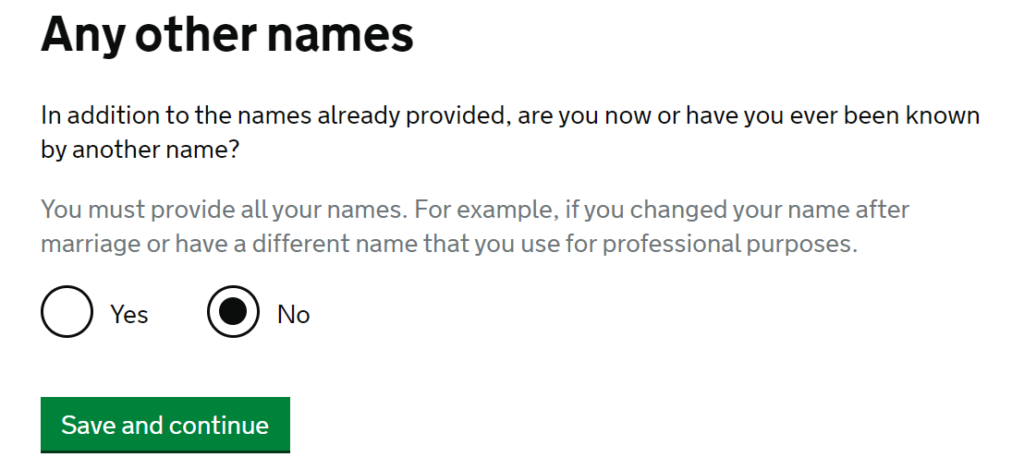
Have I ever had any other names? No.
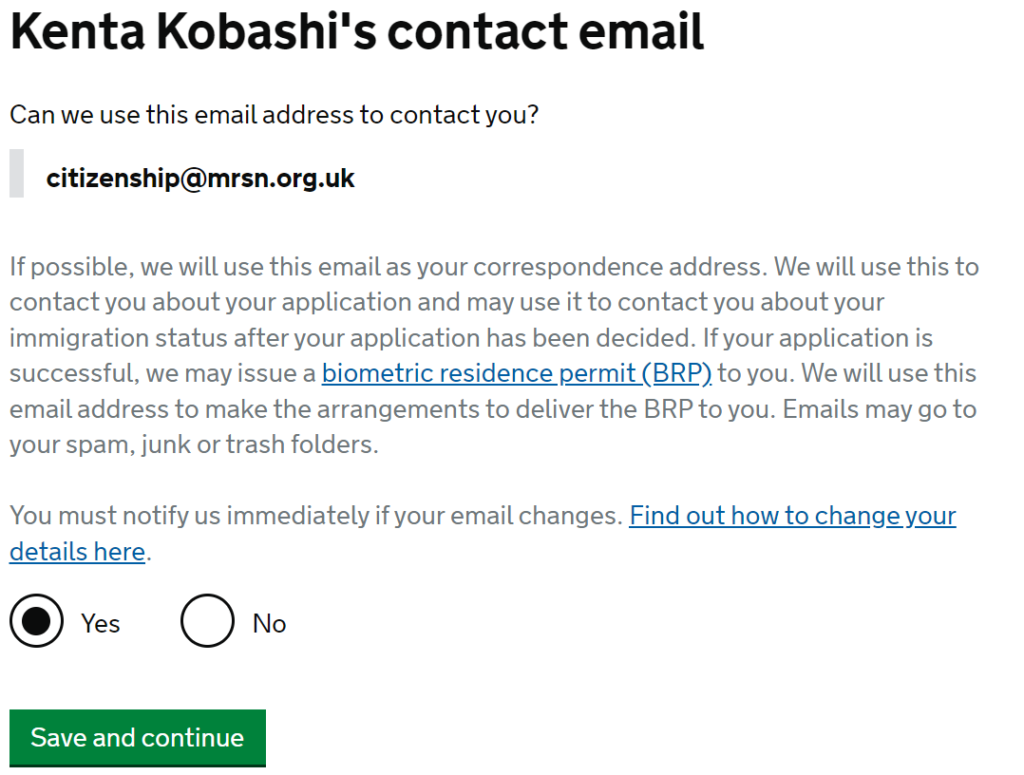
Can they contact me at that email address? Yes they can. If they have any questions about your application, they will send them by email, so make sure that you regularly check for any updates.
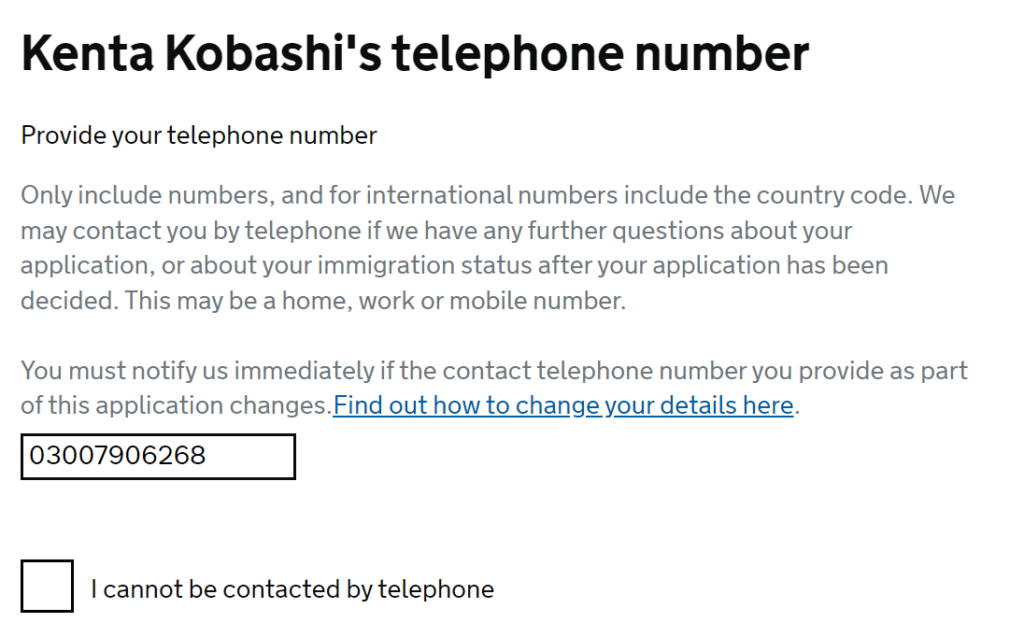
Next, they ask for my phone number. If you don’t have any phone number, you can say that you can’t be contacted by phone.

Then it asks whether you use the phone in the UK, outside the UK, or both if that’s the case.
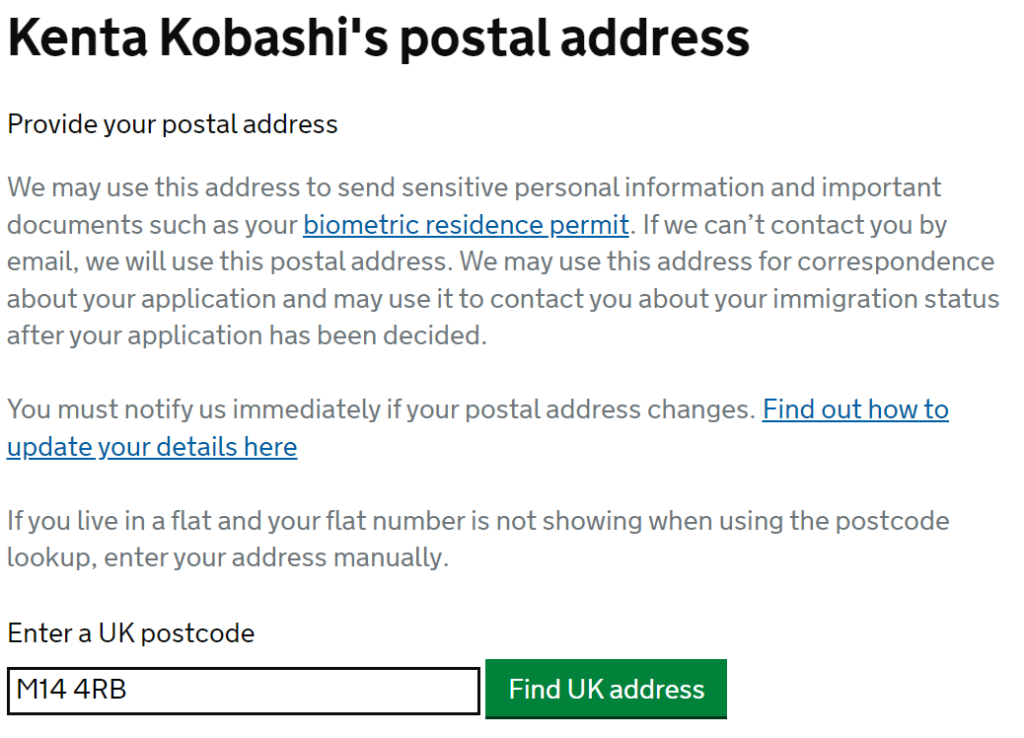
Next, it will ask about your address. First enter your postcode and click ‘Find UK address’:
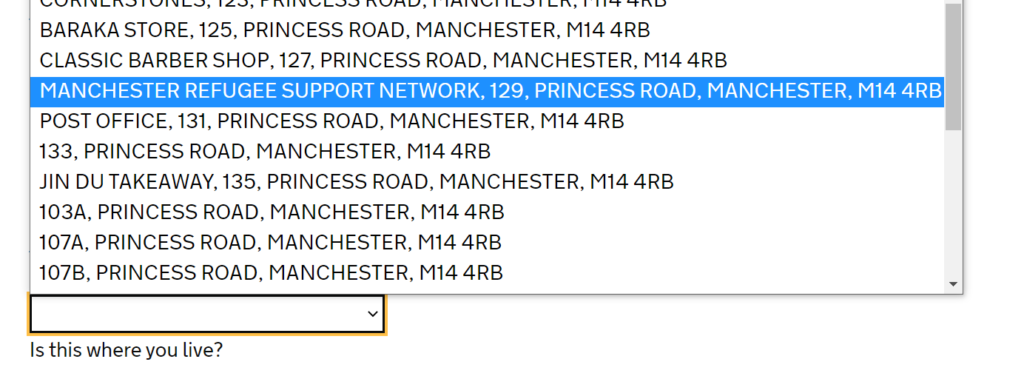
Then select your address from the list.

After you pick your address, it will ask if you live there and what month and year you first moved in. I moved into 129 Princess Road in February 1995.

Then it asks if you’ve lived at this address for more than five years. I have, but if you haven’t you’ll have to enter details of all the houses you’ve lived at during the last five years.
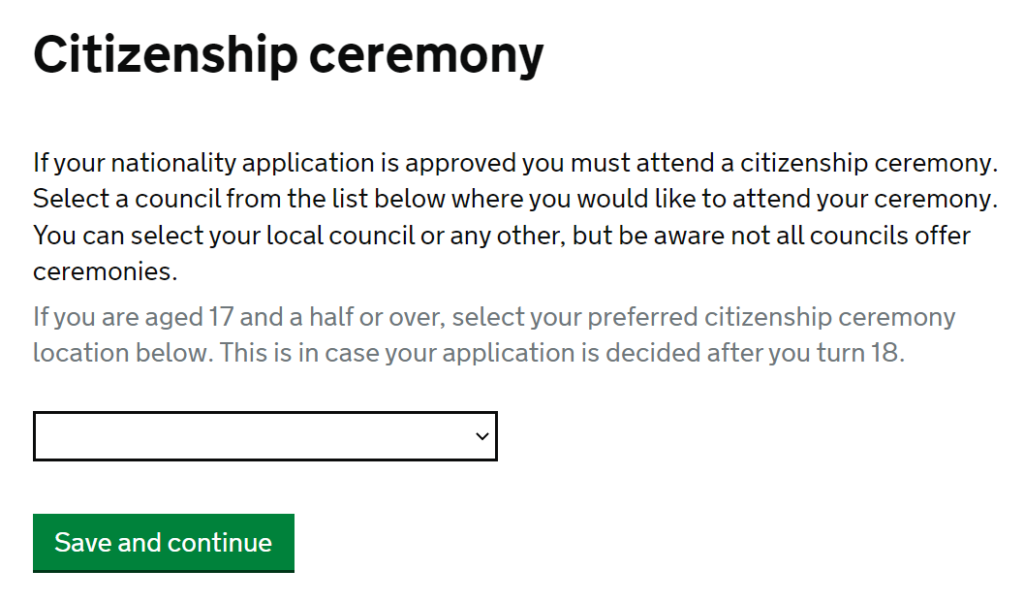
When your citizenship is accepted, you will have to attend a ceremony. It asks you to list any council that you would prefer to have this ceremony, but if you don’t write anything it will just automatically assume you want the closest council (in my case Manchester).

Then it asks about your sex and your relationship status, whether you are married, divorced, seperated etc. I am male and single.

Next, your nationality, the country you were born in and your date of birth. I am Japanese, I was born in Fukuchiyama, Kyoto, Japan on the 27th of March 1967.
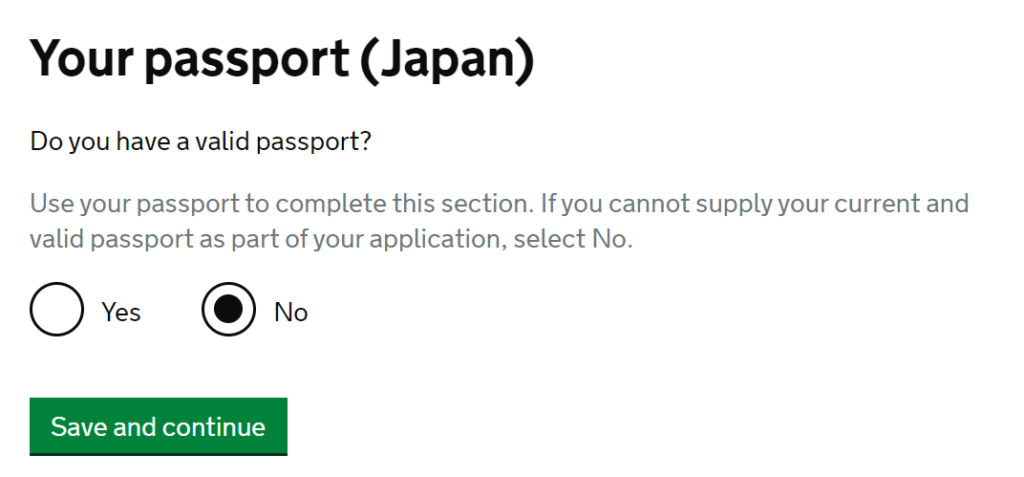
Do you have a passport from the country you were born in (not a Refugee Travel Document!)? I do not have a passport from Japan.
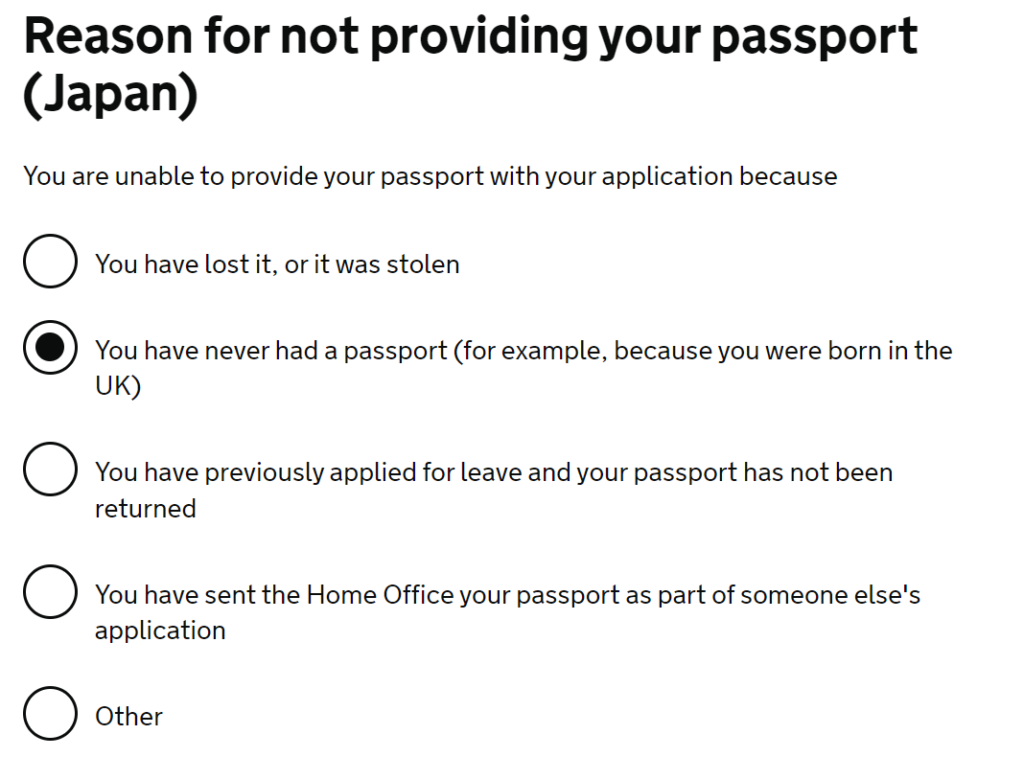
If you don’t have a passport it will ask you why. Maybe you have lost it, maybe you have sent it to the Home Office. In my case, I have never had a Japanese passport, so I select that option.
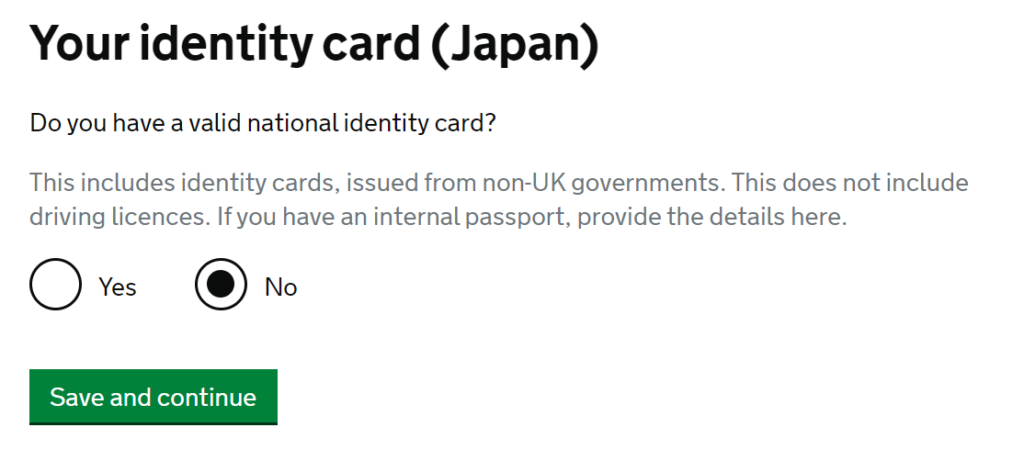
I also don’t have any ID card from Japan.
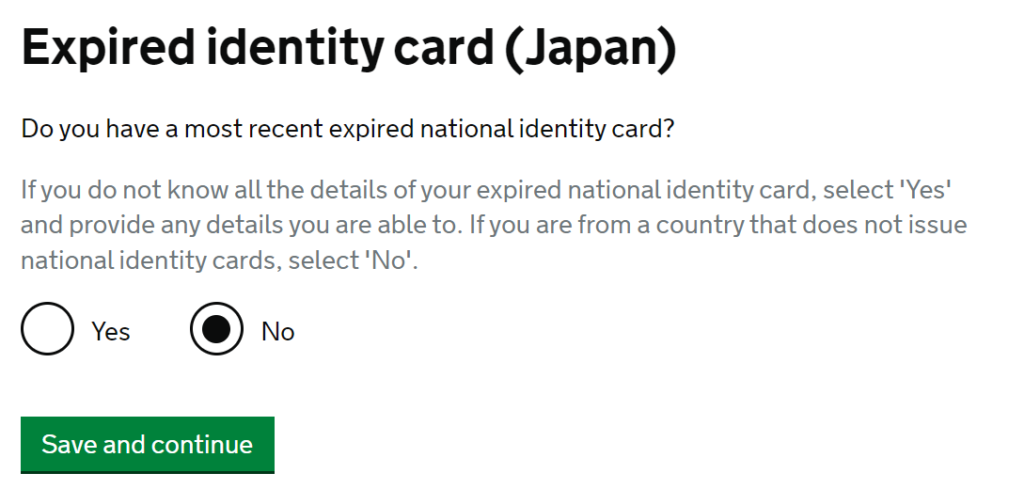
I also don’t have any expired Japanese ID card!
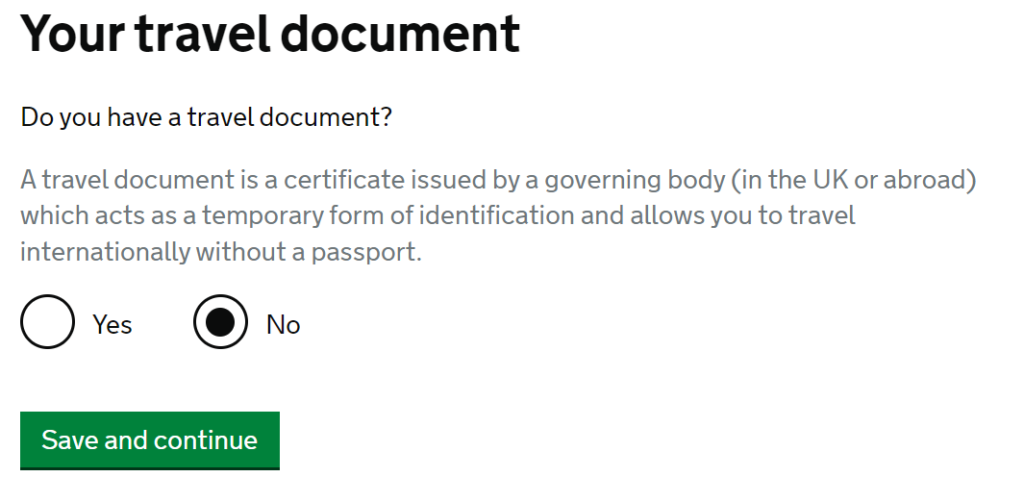
Then it asks for details of your Travel Document, including any Refugee Travel Documents. I don’t, so answered ‘No’, but if you have one…:

…then answer ‘Yes’ and enter the details here. Because I don’t have one though, and don’t have any passport, it will then ask why you can’t provide these ID documents:
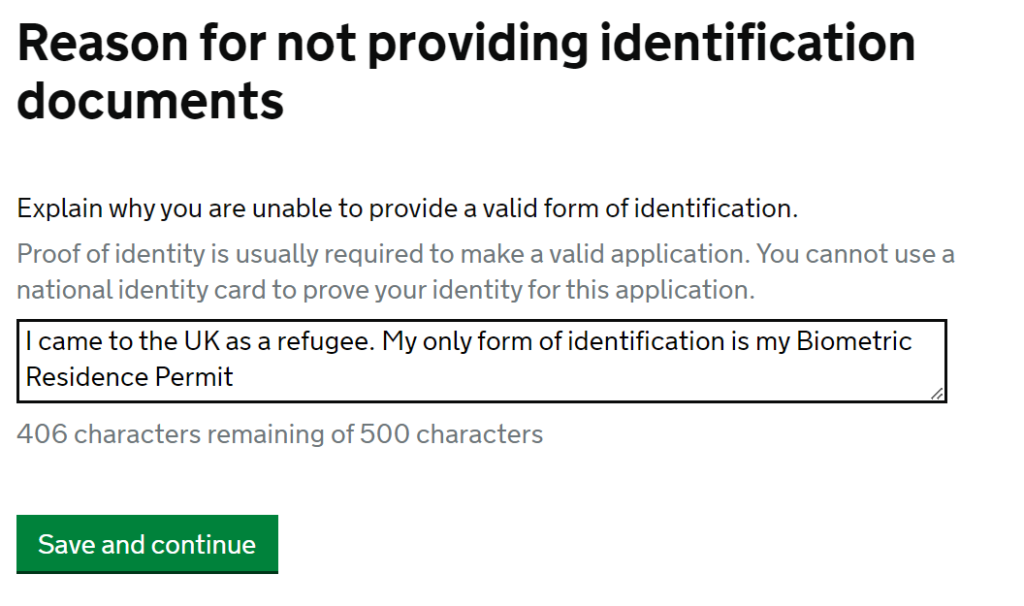
Because I am a refugee, I never had any sort of passport. I will just explain here that all I have for ID is my BRP.
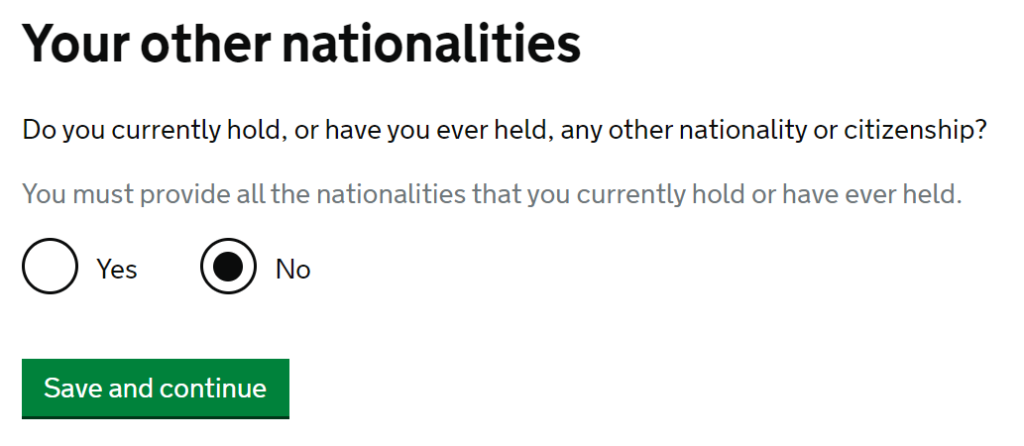
Do you have any other nationalities, apart from the one you have now? I don’t, as I have always been Japanese, but if you have ever had any other nationalities then you will be asked to give details after pressing ‘Yes’.

Next it asks about Indefinite Leave to Remain (ILR). Your ILR should be clear on your BRP:
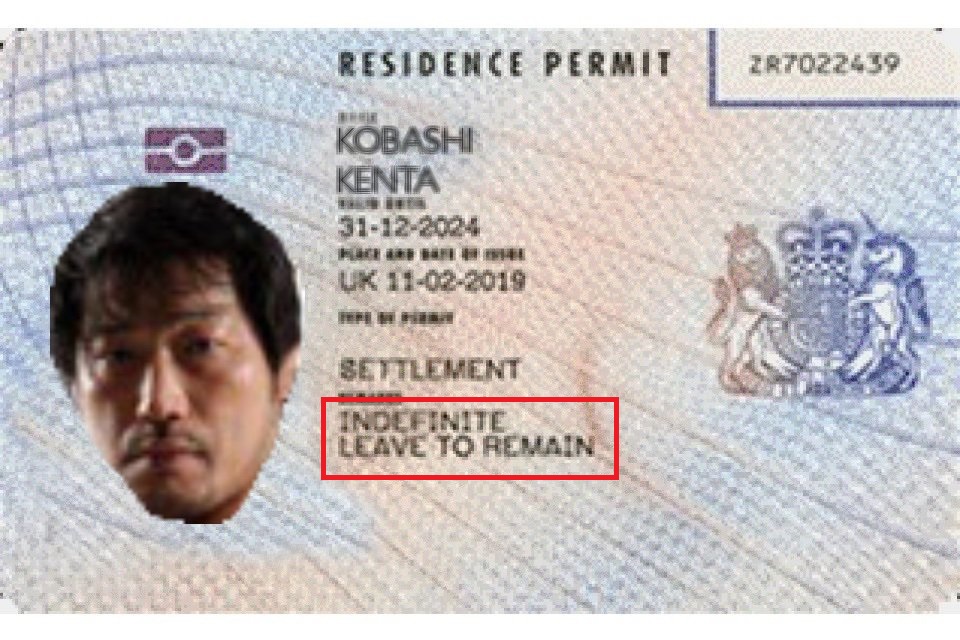
And your BRP should also contain the date that ILR was granted:
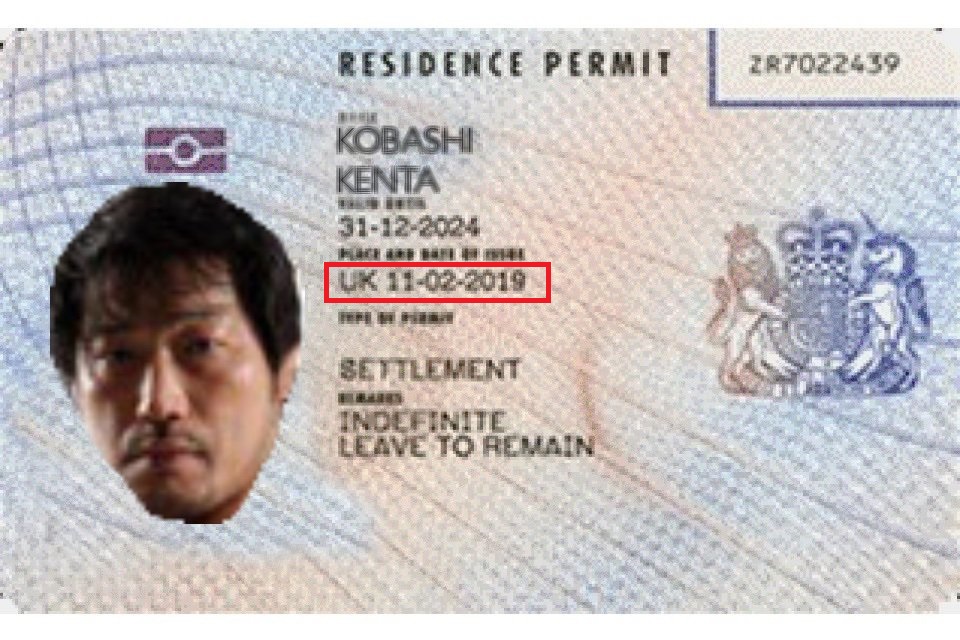
You can add these details into the application.

My ILR wasn’t granted under the EU Settlement Scheme (EUSS) because I am not not European or a family member of an EU national. If you have EU settled status (not just presettled) then you might not have a BRP at all, but an email or a letter granting you settled status, and you will need to enter the date you received that letter.

Next, it will ask for your national insurance number.

Next it asks about the Life in the UK test! When I passed the test, my results were sent to me in an email:
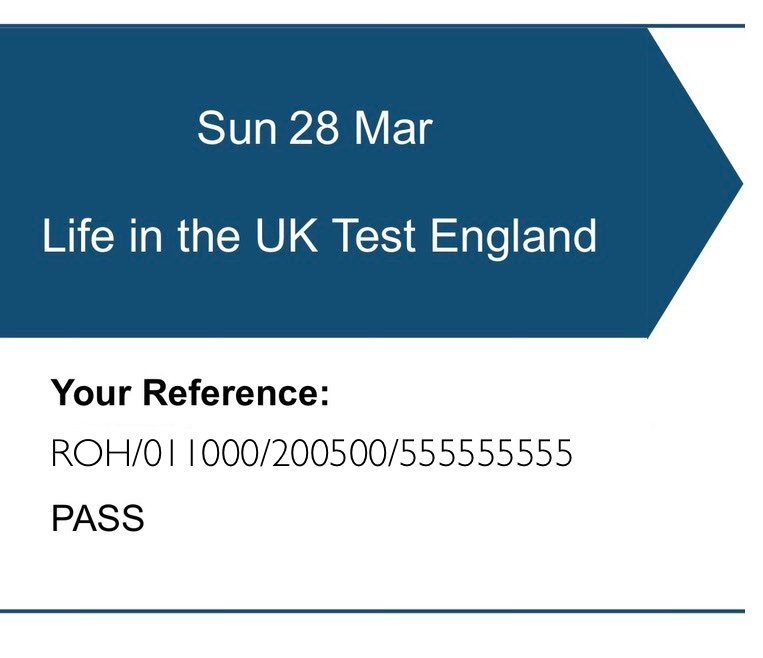
So I just need to put these details into the application:

It’s an extremely long reference number, though if you did your test a few years ago it might be much shorter set of numbers.

Have you had to prove your English on a previous UK Visa application? I entered as a refugee, so I have not.

Next, it asks if you had to prove your English when you applied for ILR. Many immigration routes require this, but not Refugee settlement, so I answer ‘No’.

Do you have a university degree that was taught in English? If so, that would prove your English level. Unfortunately, I do not.
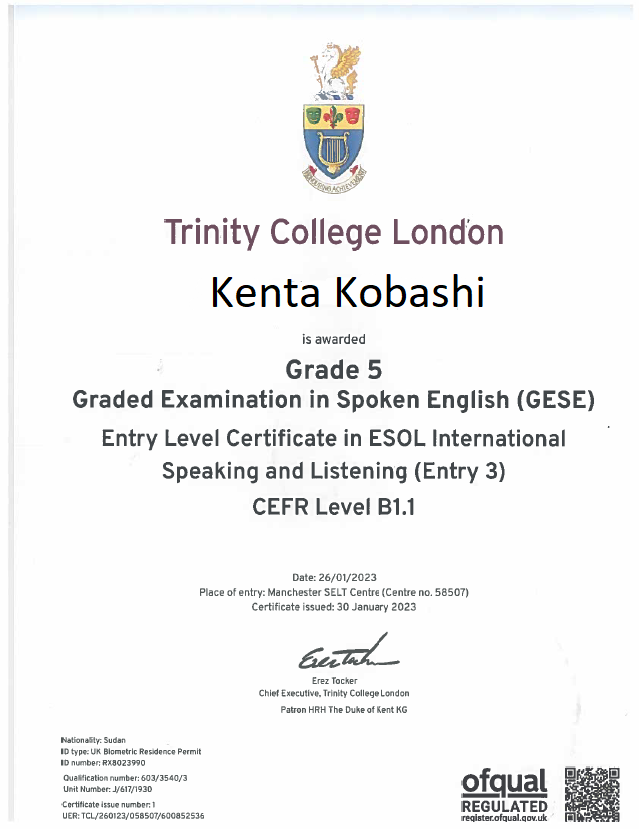
However, I have passed an approved English test and have a certificate, so when it asks about that…:

…I will add the details to the application. You might have done an exam that gave your results in the form of an online reference number. If so, enter that number here.

Next, it asks for details about your parents. If you don’t know any details about your parents, then it’s perfectly fine to say that.


However, I am able to enter the details of my mother…


…and my father.

Then you have to say whether you have any convictions or any sort of criminal record. If you do, that doesn’t necessarily mean that you can’t apply for citizenship, but you should speak to an advisor first. I am lucky enough to have none of these.

If you are on the sex offenders register, it will likely be thought of as a much more serious offence and will likely disqualify you from citizenship.

Have you ever been declared bankrupt? If you have, you will almost definitely know about it, but if you’re unsure here’s an explanation.

Do you have any children or dependants that aren’t applying for citizenship at the same time? I do not.

Have you committed any war crimes?? I hope you haven’t, but if you’re unsure you might want to look at the definition of war crimes from the International Criminal Court Act 2001. I haven’t commited any, I’m pleased to say.

Any terrorist activities?? I hope not, as that would likely have much bigger consequences than not being able to apply for citizenship.

What about terrorist organisations? Have you ever been a member?? Again, hopefully not.

Do you even have any terrorist views??

Then there are three more questions about your character, including if you’re a bad person, if you’ve ever done bad things, or if there’s anything else you’d like to make them aware of about your character. Hopefully, the answers to all of these should be ‘No’.
Then, it’s onto the referees:

Remember that your application requires two referees who can support your application for citizenship, and also confirm your likeness by signing a declaration. That declaration will be availible to download after the application, or you can download it here. This will need to be printed out twice and signed by your referees after your passport photo has been attached to it.
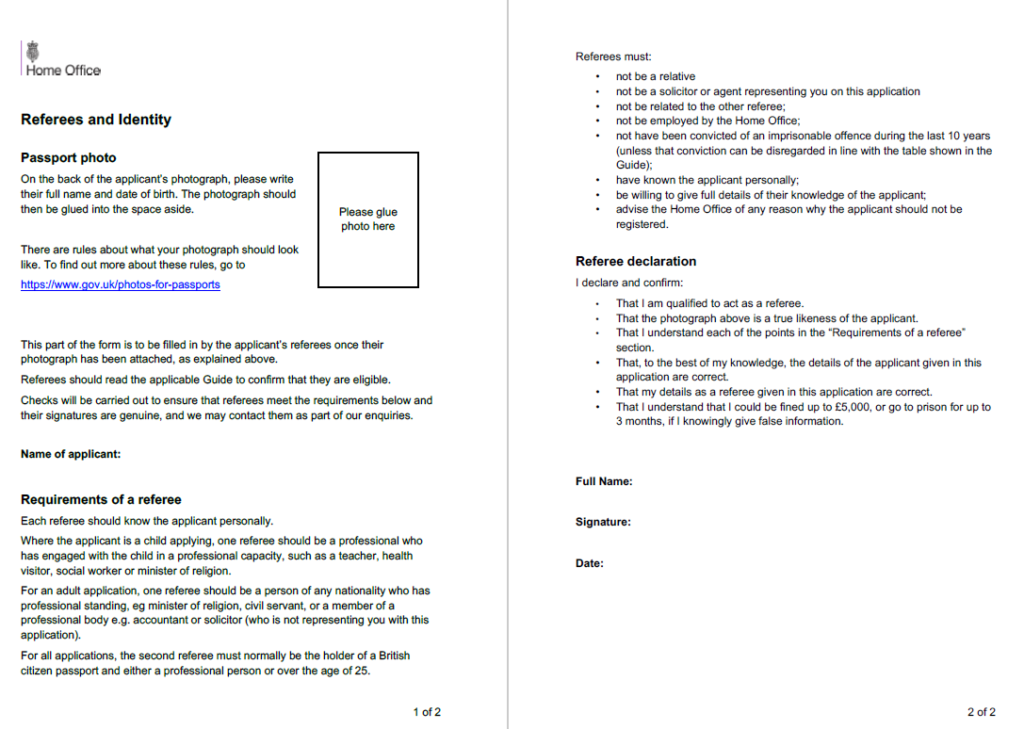
Your first referee should have a British passport, and can either be a professional person or over the age of 25 and has to have known you for more than three years. I have named my good friend and colleague Mitsuharu:


There is two page of referee’s details:
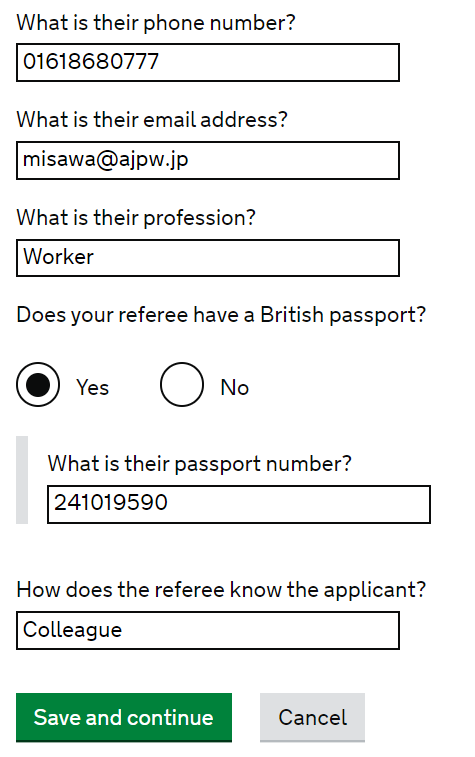
This would be where you would enter your first referee’s passport number.
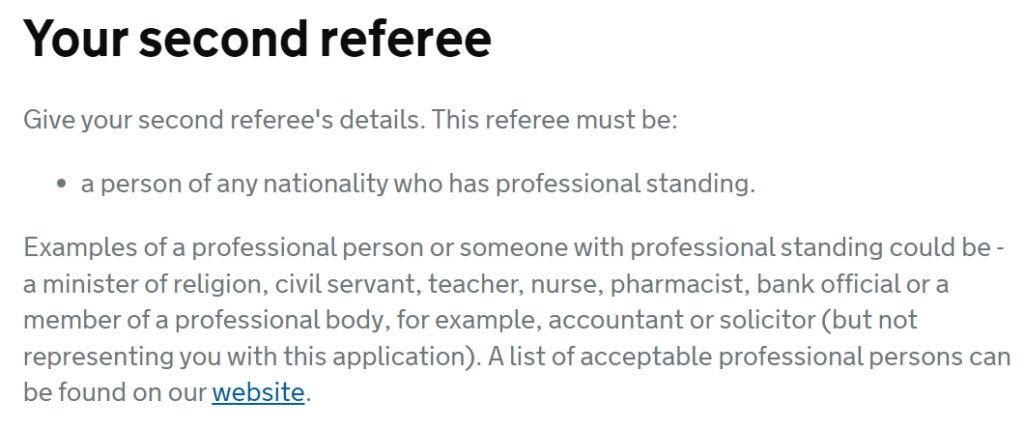
Your second referee can be from any country, but they need to be some sort of a professional. You can read more about what qualifies as ‘professional’ in the guidance, but it generally means a teacher, health worker, solicitor etc. I happen to know a university lecturer, Dave Meltzer, so I enter his details:



Next, there are questions about your BRP card:
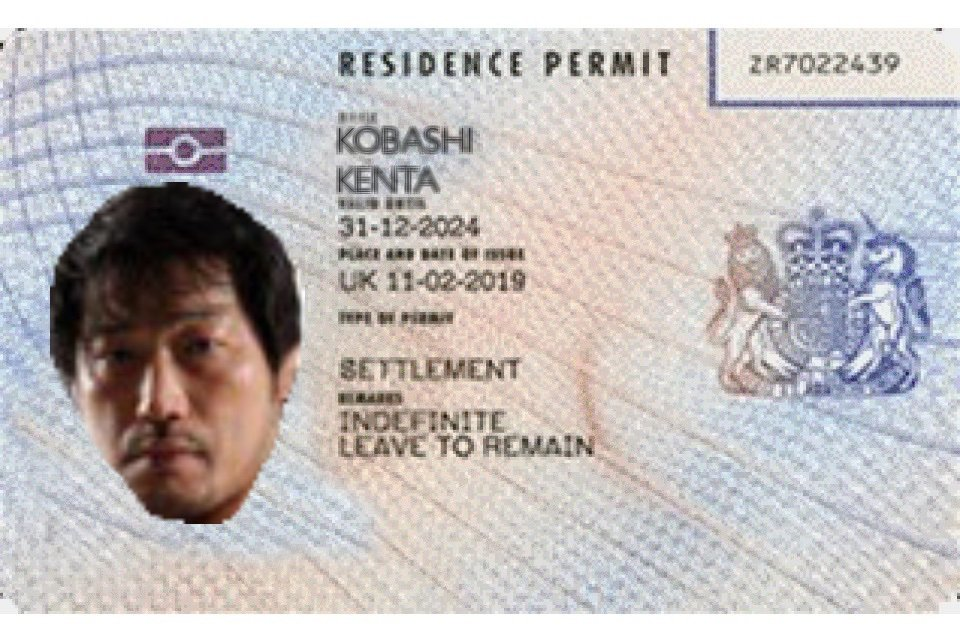
You’ve already seen my BRP…

…so I can answer ‘Yes’ to this question…

…and enter the details here.
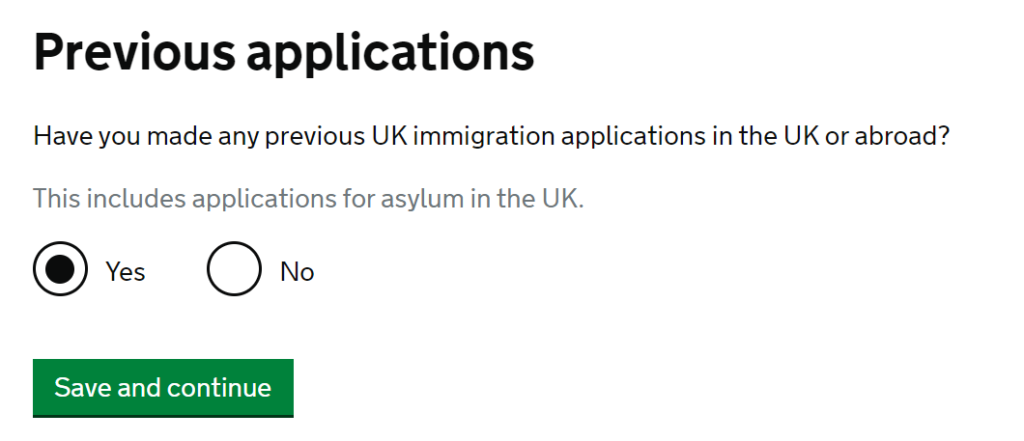
Next, it asks you about previous UK immigration applications in the UK. Your answer will differ depending on how you entered the country and what applications you made to further your leave, but if you are a refugee with ILR like me then you are likely to have made two applications:

My first application was when I claimed asylum in the UK. I made it in the same name, and I did it in 2014. I can’t remember the exact date, so I’ve just put the 1st of January. It won’t be a problem if these dates aren’t exactly correct. I claimed asylum in the UK and gave my fingerprints, but can’t remember the date my fingerprints were taken. Again, this isn’t a big problem.

Then it asks if I have made any additional applications. I have clicked ‘Yes’, because I also applied for ILR, which counts as an immigration application.

Same name again. I can’t remember the exact date, so just entered the date it was granted from my BRP card. It was made in the UK and my fingerprints were taken, but I can’t remember when that was exactly.

Again, it will ask if you made any other immigration applications. Those two are it for me, but you might need to add more. Talk to an advisor if you’re unsure of which immiration applications you’ve made or how many.

Have you previously been married? I haven’t, but if you have you would give your former partner’s details here.

Do you have any children with someone other than your current partner?? It doesn’t apply to me, as I don’t have a current partner, so I select ‘No’.

I also don’t currently have a job, as I retired back in 2013. If you have a job you would press ‘Yes’ and then enter the job’s details.
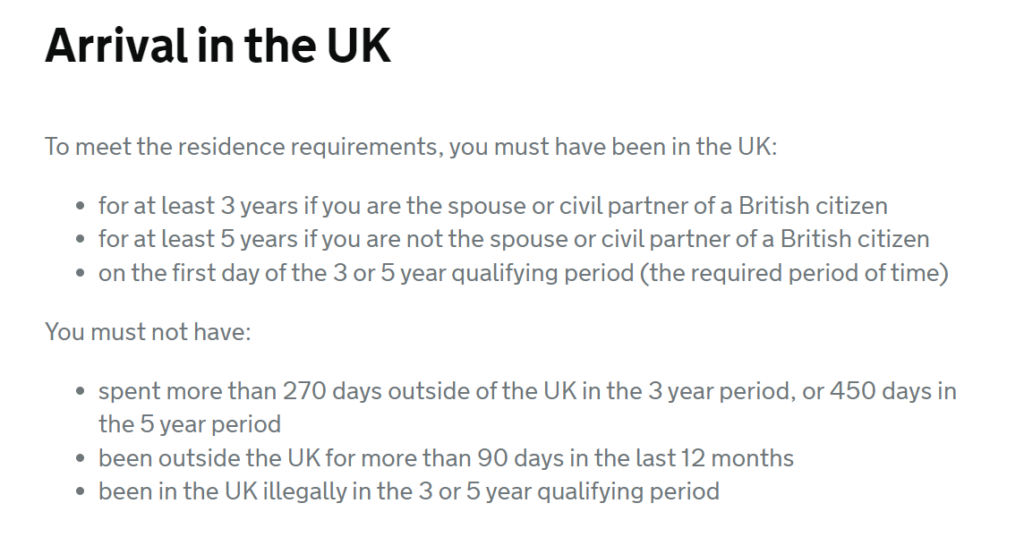
Next is the question about arriving in the UK, and a reminder that you need to have been in the UK for at least five years (or three if you are married to a British person, but this guide is focused on people who aren’t) and you can’t have been out of the country for more that 450 days in that time (and no more than 90 days in the past year).

I first entered the UK on the 1st March 2002 hidden on a lorry entering Dover.
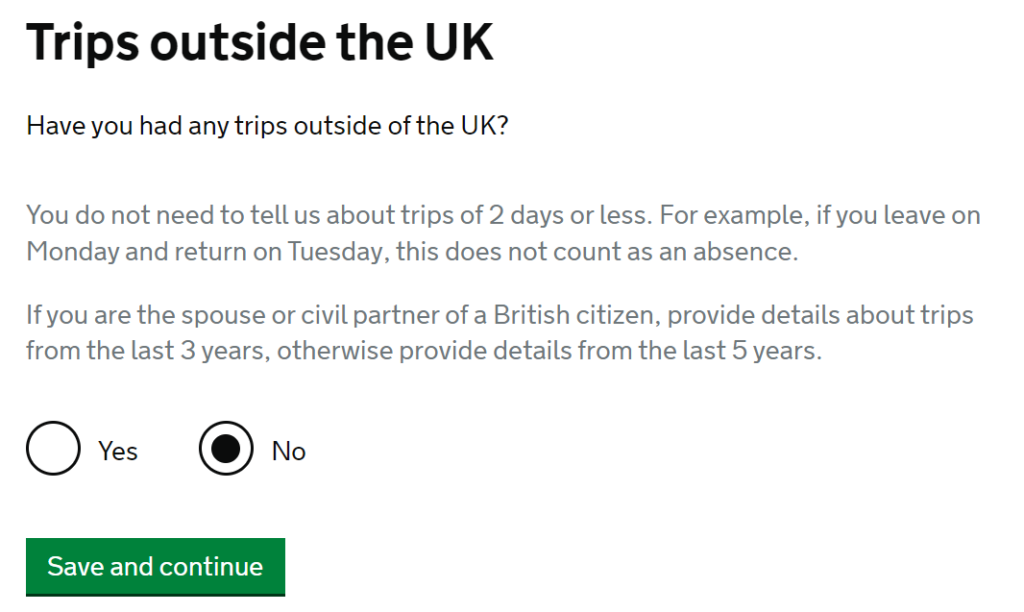
It then asks about your trips out of the UK in the last five years. I haven’t left the country in this time, but if you have had any foreign holidays then you would have to put the details in here.

Are you planning to stay in the UK after you get citizenship? I certainly am.

Next the all important residence requirements. You already know that you need to have been in the country five years, but you need to think about how you can prove this.
- Not having a passport/Travel Document is not counted as proof that you never left the country.
- But if you have a passport or Travel Document that covers those five years, then that is evidence that you never left the country, as it would show every time you entered/left the country in that five year period. Yes, it’s pretty dumb, but we don’t make the rules.
- If you don’t have any passport/Travel Document, then you need to get a little more creative:
- You can ask for a record of your Natinal Insurance Contributions, as even if you were on benefits you would have paid tax and that will prove that you’re in the country. You can apply for this through your Government Gateway account, via this online form, or by phoning 0300 200 3500.
- If you are at school/college/university, you can get a letter confirming that you attend and saying how many hours you do a week
- If you have worked for these five years, you could get a letter from your employer confirming when you started working there and for how many hours a week you work.
- Utility bills are not accepted, and they generally advise against sending bank statements.
- However, if you have Council Tax bills that cover the five years and have your name on it, that would be accepted
- If you still can’t think of any way to prove your residence, talk to an advisor
I selected ‘Yes’, because I know that I can prove this residence

If you’ve completed this form and meet all the requirements, then these questions don’t apply to you. If you don’t make the requirements, then paying for this application will almost definitely be a waste of money!

And if you meet the requirements, you don’t need anything else to be considered!
Finally, it gives you a chance to check your answers:

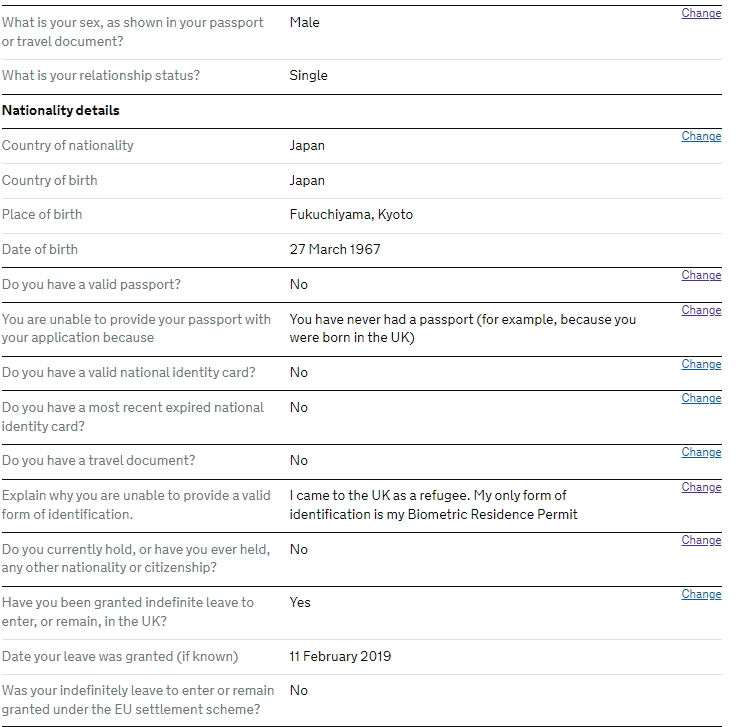
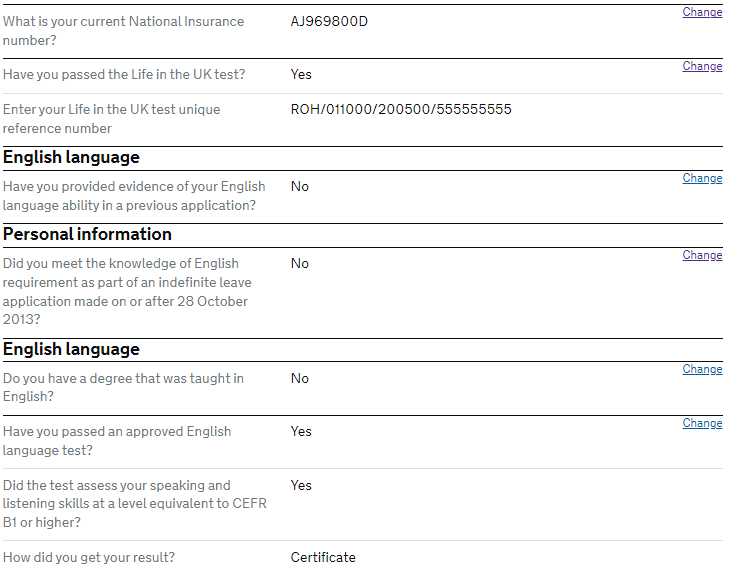

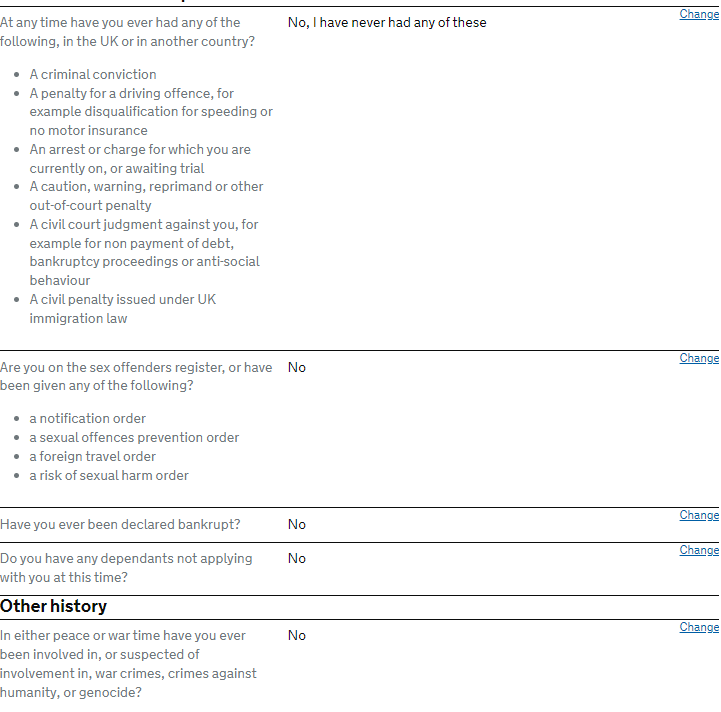
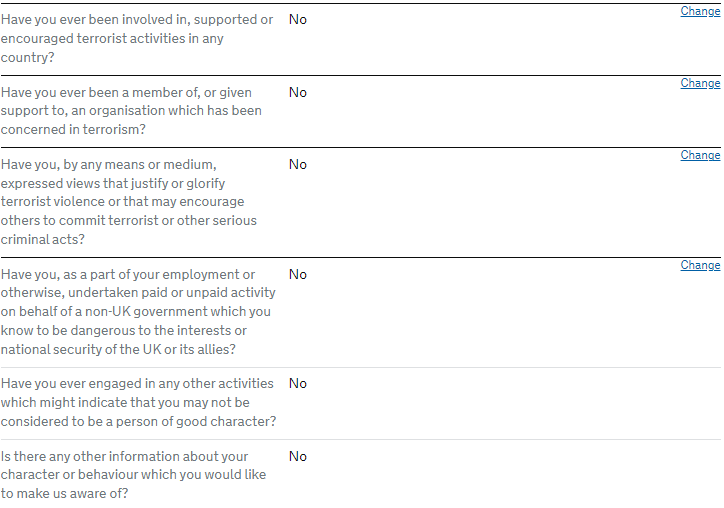
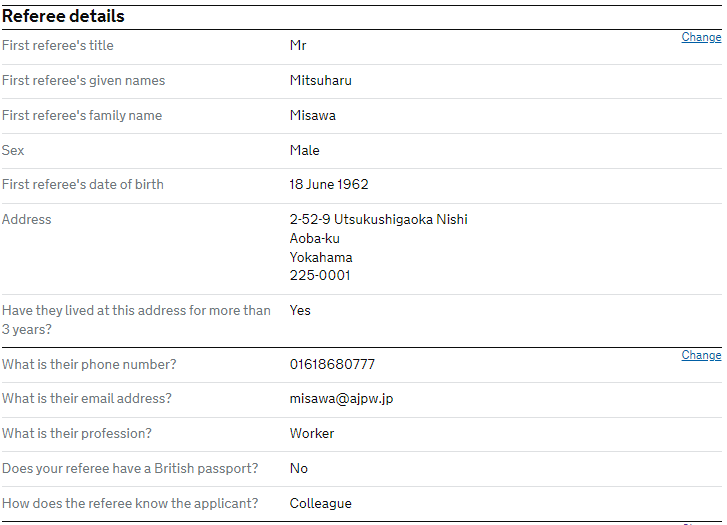
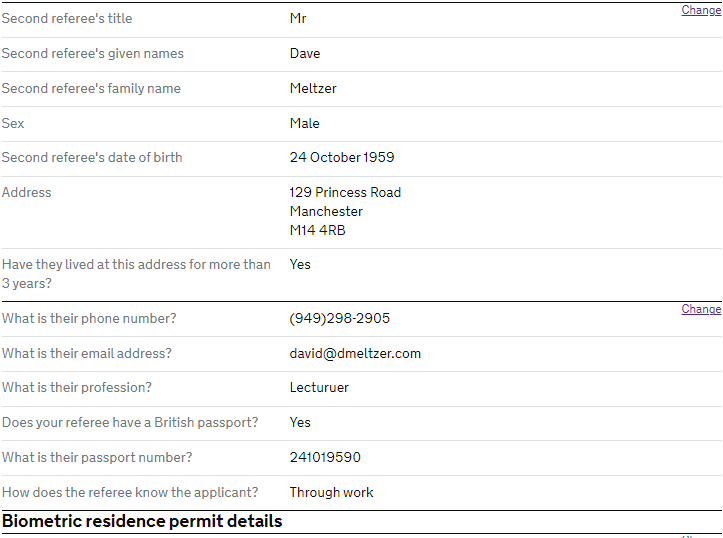


Phew! And the application is finished!
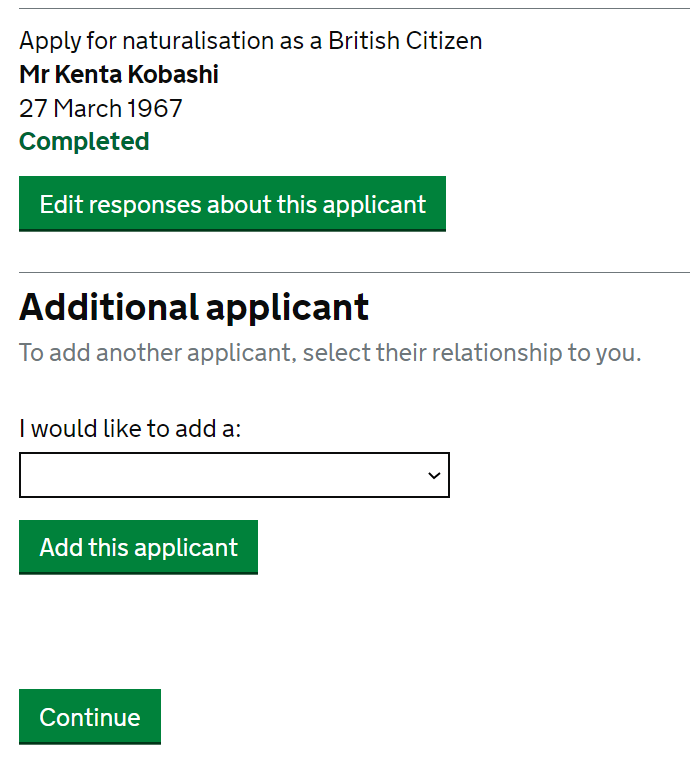
As you can see, Kenta Kobashi’s application is marked as ‘Completed’. There is an option to add another applicant:
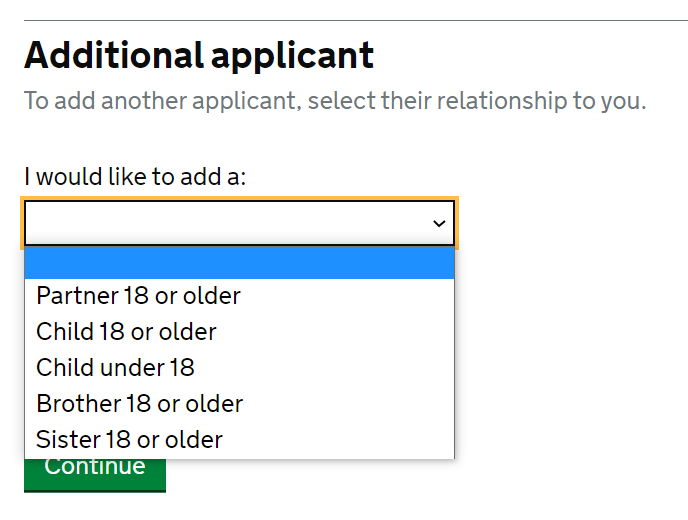
If you wanted to make multiple applications at once, you could also apply for your partner, child or sibling. But I’m just applying on my own, so I’m just going to ignore that and press ‘Continue’.

Next the documents you will have to provide as evidence! It says that you should provide as much as you can, and ideally you should be able to supply everything they’ve asked for.


First, it mentions my BRP. That’s easy enough:
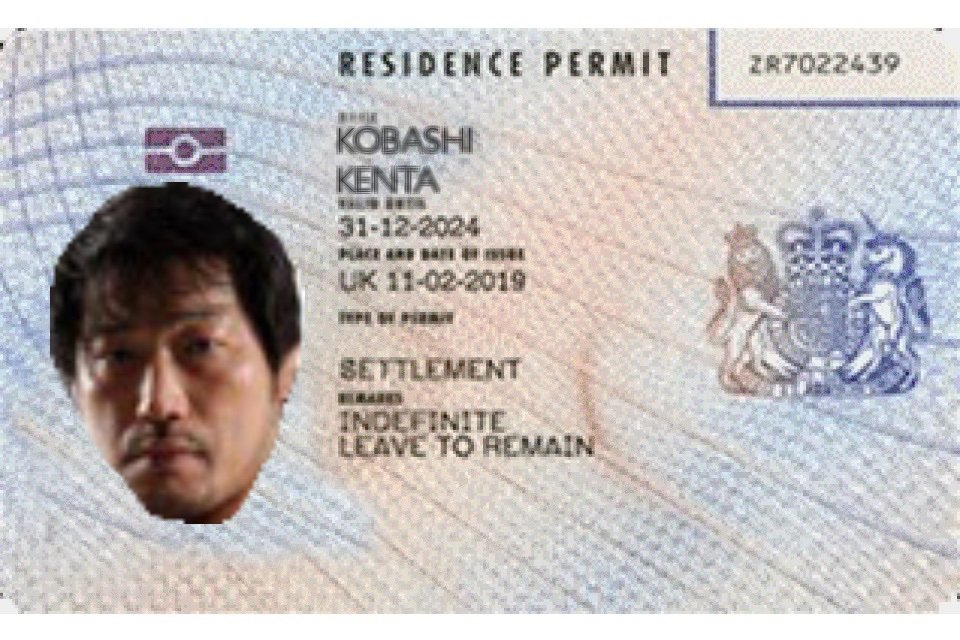

Next, it asks for something that proves your knowledge of English. Again, easy enough for me, as I have that certificate:
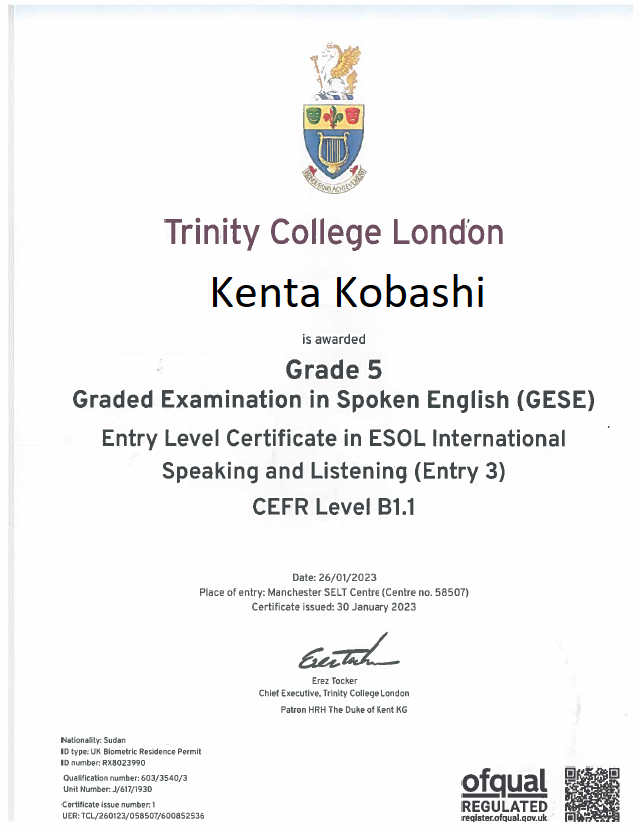

Next, it will ask of proof of your five year’s residence, which we have just discussed.
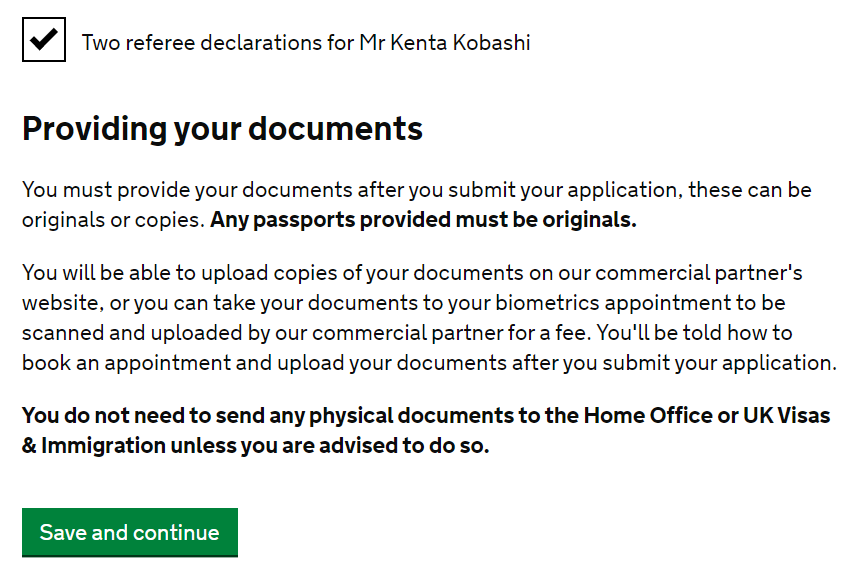
Then it asks for two signed referee declarations, which we’ve mentioned before and will talk about in a second, and then you can click continue.

This is where you’re able to download the referee declarations, if you haven’t done so already. Remember, you need to print two of these off, attach your photo to both of them, and get your referees to each sign their names on the back.
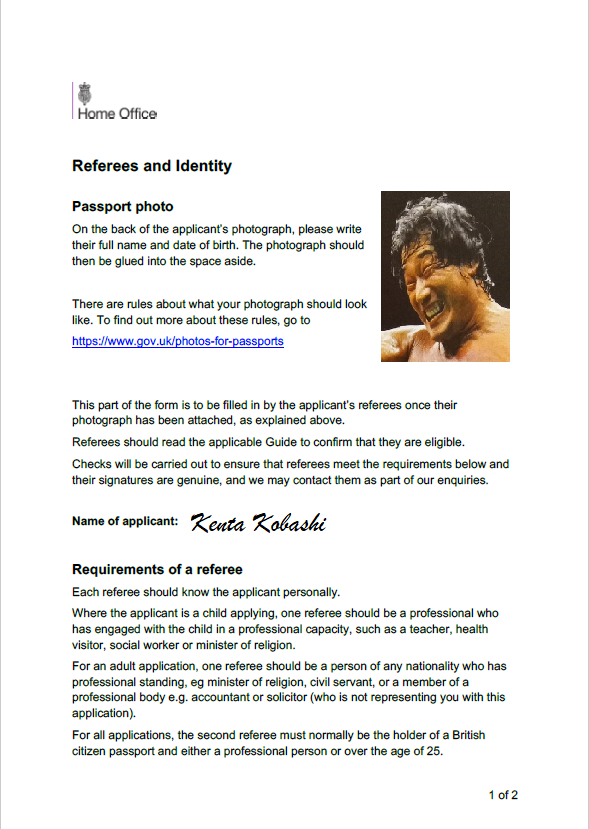
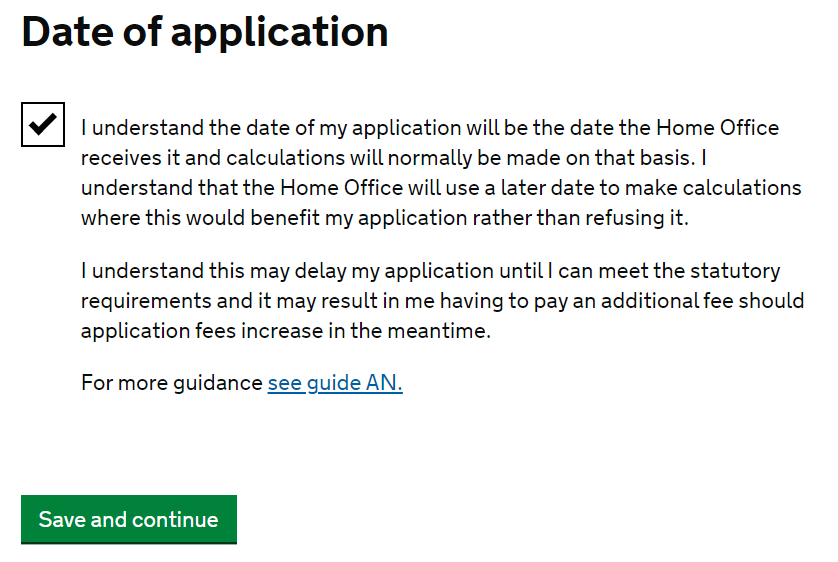
This is just to confirm that you understand that the date you make your payments is the date that the application will officially be made. It’s also important to realise that you need to have been in the UK exactly five years before the day you make your application. So if you’re making the application on the 19th of May 2023 make sure that you weren’t on holiday on the 19th May 2018!!

And just one more confirmation that I, Kenta Kobashi, am the applicant.
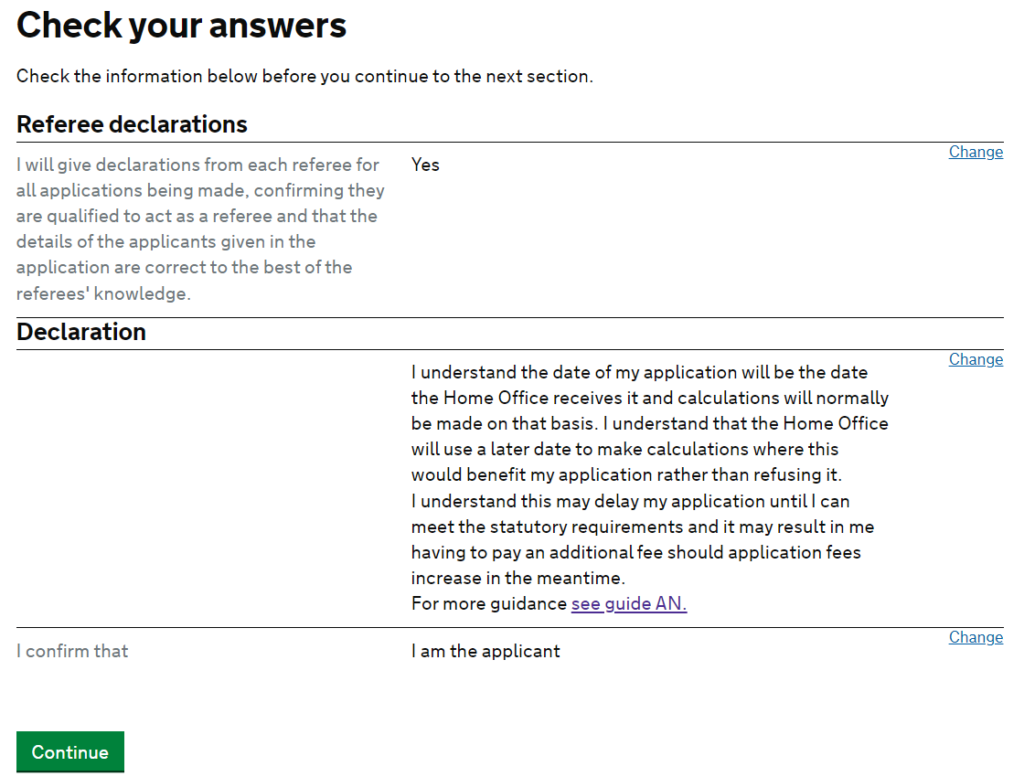
A chance to check those last answers.

And here it is, you’re committing to pay one thousand three hundred and thirty non refundable pounds!

It says that you can’t edit your answers after you click ‘Continue to WorldPay’, but this is incorrect, you can press cancel before entering your card details and return. However, once you’ve paid there’s no going back!
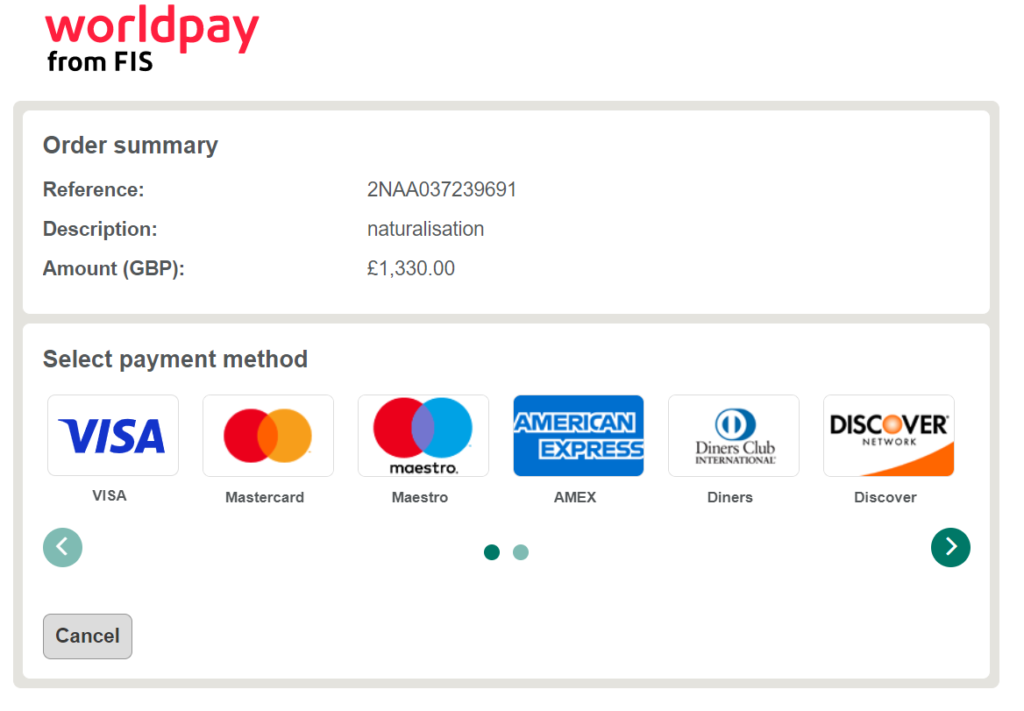
Click on which card type you have (you can only pay by bank card, unfortunately).
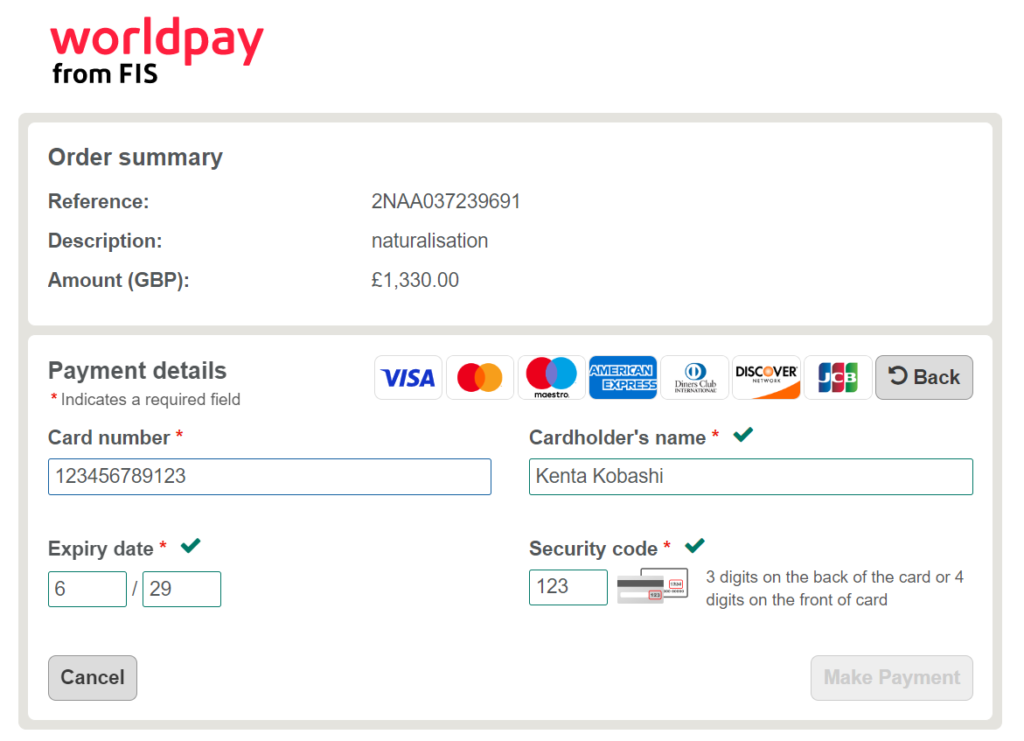
Enter your card details and…

This is the end of the guide for now, and we’ve gone over everything you need to do to fill out a citizenship application as an adult with at least one year ILR. After you pay your money it’ll be time to book an appointment to get your biometrics taken and upload all the evidence we’ve mentioned. If you’re confident you’ll be able to do that then pay your money and go ahead. If you’re not, you might want to come and speak to an advisor at MRSN after you’ve completed the application.
Eventually we shall post a guide to giving your biometrics/evidence, and also to applying for child’s citizenship and for a fee waiver. For now though, we hope this guide to citizenship applications is useful.
